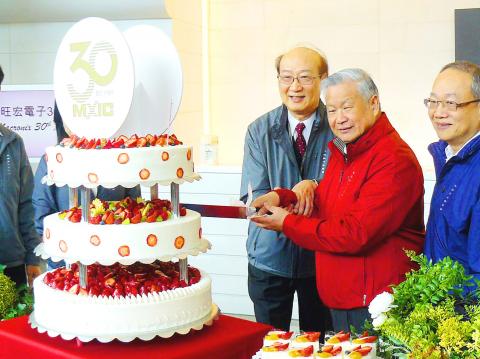Memorychip maker Macronix International Co (旺宏) yesterday said that it is shipping high-density memory chips for Huawei Technologies Co’s (華為) 5G base stations and expects client demand for the chips to peak next year or in 2021 in step with the global deployment of the next-generation wireless networks.
Other than Huawei, “80 percent of the [world’s] 5G companies are adopting our chips as well. Those [clients] are from China, Japan, Europe and South Korea,” Macronix chairman Miin Wu (吳敏求) told reporters at the company’s headquarters in Hsinchu.
“I believe the company is a major supplier to those [5G] clients,” he added.

Photo: CNA
As global telecom operators are just beginning to install base stations this year, shipments of Macronix’s memory chips used in 5G base stations are expected to peak next year, or the year after, Wu said.
He said that 5G base stations are expected to require a significant amount of memory chips, as they are usually equipped with high-density NOR flash with 1 or 2 gigabytes of memory.
Not only 5G technology, but also true wireless stereo earbuds are driving demand for memory chips and boosting memorychip prices, Wu said.
“Based on the information on hand, I think [prices] will grow mildly. The semiconductor looks quite good... There is room for price increases in the second half next year,” he said. “Demand for NOR flash and NAND flash memory chips should surpass supply sometime next year.”
Macronix expects demand to improve every quarter next year, he said.
Macronix, which turned 30 earlier this month, plans to ship its first 3D 48-layer NAND flash memory chips in the second half of next year, with the first batch going to Nintendo Co.
The chipmaker said that 3D 96-layer NAND flash memory chips would follow in 2021 and 192-layer chips in 2022.
To celebrate its 30th anniversary, Macronix is exhibiting innovative technologies and products — such as chips used in autonomous vehicles, automated external defibrillators, Fibit Inc’s smart watches, drones and Nintendo Co’s Switch game consoles — in a new showroom at its headquarters.
The company aims to grow its revenue from medical, industrial and automobile devices to make up 50 percent of the company’s revenue in the long term, compared with the current 25 percent, Wu said.
Macronix invests 15 percent of its annual revenue in research and development (R&D) and had 7,950 patents granted as of October, the company said, adding that about 20 percent of its 40,000 employees are R&D staff.
Macronix said that it would give a NT$10,000 (US$328) bonus to each employee to celebrate its anniversary.
In other words, it would pay a total of NT$40 million in bonuses, which Wu said reflected the company’s gratitude for the contribution made by its employees and support from their families.
The company reported earnings per share of NT$4.94 for last year and NT$1.21 per share for the first three quarters of this year.
Revenue for last month decreased 6 percent to NT$3.66 billion, from NT$3.89 billion a year earlier. In the first 11 months, cumulative revenue totaled NT$29.08 billion, 9 percent less than the NT$31.87 billion reported for the same period last year.
Additional reporting by CNA

Shiina Ito has had fewer Chinese customers at her Tokyo jewelry shop since Beijing issued a travel warning in the wake of a diplomatic spat, but she said she was not concerned. A souring of Tokyo-Beijing relations this month, following remarks by Japanese Prime Minister Sanae Takaichi about Taiwan, has fueled concerns about the impact on the ritzy boutiques, noodle joints and hotels where holidaymakers spend their cash. However, businesses in Tokyo largely shrugged off any anxiety. “Since there are fewer Chinese customers, it’s become a bit easier for Japanese shoppers to visit, so our sales haven’t really dropped,” Ito

The number of Taiwanese working in the US rose to a record high of 137,000 last year, driven largely by Taiwan Semiconductor Manufacturing Co’s (TSMC, 台積電) rapid overseas expansion, according to government data released yesterday. A total of 666,000 Taiwanese nationals were employed abroad last year, an increase of 45,000 from 2023 and the highest level since the COVID-19 pandemic, data from the Directorate-General of Budget, Accounting and Statistics (DGBAS) showed. Overseas employment had steadily increased between 2009 and 2019, peaking at 739,000, before plunging to 319,000 in 2021 amid US-China trade tensions, global supply chain shifts, reshoring by Taiwanese companies and

Taiwan Semiconductor Manufacturing Co (TSMC, 台積電) received about NT$147 billion (US$4.71 billion) in subsidies from the US, Japanese, German and Chinese governments over the past two years for its global expansion. Financial data compiled by the world’s largest contract chipmaker showed the company secured NT$4.77 billion in subsidies from the governments in the third quarter, bringing the total for the first three quarters of the year to about NT$71.9 billion. Along with the NT$75.16 billion in financial aid TSMC received last year, the chipmaker obtained NT$147 billion in subsidies in almost two years, the data showed. The subsidies received by its subsidiaries —

Taiwan Semiconductor Manufacturing Co (TSMC) Chairman C.C. Wei (魏哲家) and the company’s former chairman, Mark Liu (劉德音), both received the Robert N. Noyce Award -- the semiconductor industry’s highest honor -- in San Jose, California, on Thursday (local time). Speaking at the award event, Liu, who retired last year, expressed gratitude to his wife, his dissertation advisor at the University of California, Berkeley, his supervisors at AT&T Bell Laboratories -- where he worked on optical fiber communication systems before joining TSMC, TSMC partners, and industry colleagues. Liu said that working alongside TSMC